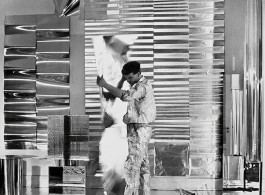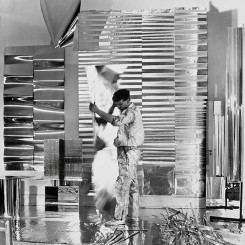“Spectrum”
Galerie Perrotin, Paris
Curated by Matthieu Poirier
Galerie Perrotin, Paris / 23 April – 4 June 2016 Opening: Saturday 23 April, 4-9pm
In 1973, the Musée d’Art moderne de la Ville de Paris presented an important retrospective of Heinz Mack’s work. Yet during the ensuing decades, as the artist’s career took on international scope, his presence diminished on the French artistic scene. The current exhibition thus proposes reviving this essential reformer from the history of abstract art. With enthusiastic support from the artist as well as major lenders and institutions, I have selected for this exhibition a substantial group of more than seventy works, including some very old ones that have never been shown in public. The presentation will exceptionally take place in all of the spaces of the Galerie Perrotin in Paris, and will link together works of various formats, natures, and periods in order to highlight the main lines, if not the “whole spectrum,” of a broad career.
From one period to another, Mack’s esthetic search has been a constant exploration—both systematic and sensual—of the lumino-chromatic spectrum and its perceptive thresholds. This immaterial goal took on a philosophical dimension for the artist, one that was paradoxically based on highly material means, and that used the raw simplicity of natural or manufactured materials such as paint, metal, wood, stone, glass, plexiglass, or sand. The variability of the manual production, both controlled and random, as well as this primitivist reduction, make Mack the source of an exceptional phenomenological unfolding. The viewer is prompted to feel the tangible experience of vision, and to consider time and space as entirely separate mediums.
The very first works characteristic of the artist appeared around 1950, in the context of the Arts Academy of Düsseldorf, and then during his philosophy studies at the local university. From the beginning the artist favored a willingly abstract and non-figurative language, while being disappointed in most of the recent developments in that trend, which he deemed academic and too indebted to traditional composition and imagery. On the other hand, the historic avant-garde of Constructivism, Futurism or De Stijl drew his attention. Around 1953-54, he quickly conceived
paintings, reliefs, and sculptures according to a radical logic, one that is still unfolding today in his daily practice, at his studios in Mönchengladbach and Ibiza. This esthetic principle includes his numerous voyages to the Sahara, where beginning in 1962 his productions and actions prefigured North American Land Art. The years between 1957-1966 were an equally crucial period: with Otto Piene and later Günther Uecker (who joined them in 1962), Mack was the founder and central figure of ZERO, a multifaceted artistic entity and international hub of the kinetic renewal of abstraction, which had Yves Klein and Jesús Rafael Soto as members, to name just a few. Numerous institutions, with the assistance of the ZERO Foundation in Düsseldorf, have recently endeavored to present this complex movement, from the Guggenheim in New York to the Stedelijk in Amsterdam, along with the Martin-Gropius-Bau in Berlin, or the Galeries Nationales du Grand Palais in Paris with the exhibition “DYNAMO”—whose title I had suggested in reference to the repeated use of the term by Mack himself during this historical period. The 1970s and 1980s fall within a single esthetic singularity, in which a number of Mack’s sculptures—including numerous steles and other obelisks that were willingly off scale—engaged in a rich dialogue with architecture and urban space, primarily throughout all of Germany.
On his business card, Mack presents himself as a “sculptor and painter”. The order in which these mentions is important, as it gives precedence to the modulation of matter in space over the creation of images on a painting’s surface. In other words, even the canvases stretched over frames—paintings—from the ZERO period are covered in a material whose abundant impasto pushes them toward the relief, that intermediary domain of art history somewhere between painting and sculpture, and whose elements are significantly raised from the surface on which they are fixed. Their appearance remains ambiguous, even paradoxical, making it difficult to fix them mentally or photographically. For Mack’s work exists only in a double movement of appearance and disappearance. The unstable material is constantly eroded by darkness or light. We have a paradox here—one that is inseparable from the history of Kinetic art and Perceptual art, of which Mack was a central figure—between the tangible simplicity of the material fact, and the insolvable mystery of its effects.
Matthieu Poirier
On the occasion of the exhibition Galerie Perrotin and Editions Dilecta publish a monograph including a text by Matthieu Poirier.
A conversation between Heinz Mack and Matthieu Poirier will occur the day of the opening, on Saturday April 23 at 6pm at Salle de Bal – 60 rue de Turenne, Paris 3è.
Heinz Mack was born in 1931 in Lollar (Germany). He lives and works in Mönchengladbach (nearby Düsseldorf), Germany and Ibiza, Spain
SOLO EXHIBITIONS (Selection)
2016 Sakip Sabanci Museum, Istanbul
2015 Museum Frieder Burda, Baden-Baden, Germany; Ulmer Museum, Ulm, Germany; MKM Museum Küppersmühle, Duisburg, Germany
2014 Leopold-Hösch-Museum, Düren, Germany; “The Sky over Nine Columns”, Installation on the island of San Giorgio Maggiore, Fondazione Cini / Beck & Eggeling
International Fine Art, Venice
2012 Museum Ostwall im Dortmunder U Zentrum, Dortmund, Germany
2011 Kunst- und Ausstellungshalle der Bundesrepublik Deutschland, Bonn, Germany; Stiftung Museum Kunstpalast, Düsseldorf, Germany 2009 Ludwig Museum im Deutschherrenhaus, Koblenz, Germany
2006 “Transit zw. Okzident und Orient,” Pergamonmuseum, Berlin
2001 Tehran Museum of Contemporary Art, Tehran, Iran
1978 Städtisches Museum Abteiberg, Mönchengladbach, Germany
1977 Stadtmuseum, Munich, Germany
1973 Stedelijk van Abbemuseum, Eindhoven, The Netherlands; Musée d’Art moderne de Ia Ville de Paris
1972 Akademie der Künste, Berlin
1970 “Lenk Mack Pfahler Uecker,” 35th Venice Biennale
1967 Galerie Denise René, Paris
1966 “Forest of Light,” Howard Wise Gallery, New York
1962 “Mack Piene Uecker,” Palais des Beaux-Arts, Brussels
1960 New Vision Centre Gallery, London
1959 Galerie Iris Clert, Paris
1957 Galerie Schmela, Düsseldorf, Germany
GROUP EXHIBITIONS (Selection)
2016 “Eye Attack – Op Art 1950-1970,” Louisiana Museum, Humlebaek, Denmark
2014 “ZERO – Countdown to tomorrow, 1950-1960s,” Solomon R. Guggenheim Museum, New York; “Seeing through light – Selections from the Solomon R. Guggenheim
Museum, Abu Dhabi,” Solomon R. Guggenheim Museum, Abu Dhabi
2013 “DYNAMO 1913 – 2013,” Galeries nationales du Grand Palais, Paris
2012 “Ghosts in the Machine,” New Museum, New York
2011 “Nul = 0. Dutch avant-garde in an international context, 1961-1966,” Stedelijk Museum, Schiedam, The Netherlands; Painterly Abstraction, 1949-1969. Selections from the
Guggenheim Collections,” Guggenheim Museum, Bilbao, Spain
2009 “Infinitum,” Palazzo Fortuny, Venice
2008 “spot on: 50 Jahre Zero in Düsseldorf,“ Museum Kunst Palast, Düsseldorf, Germany
2007 “Guggenheim Collection 1940 to now,” International Gallery of Victoria, Melbourne
2006 “Zero,” Museum Kunst Palast, Düsseldorf; Musée d’Art moderne et contemporain de Saint-Étienne Métropole, France
2004 “Beyond Geometry. Experiments in Form 1940-1970,” Los Angeles County Museum of Art, Los Angeles
2001 “Open Ends,” Museum of Modern Art, New York
1997 “Zero International – Zero et Paris 1960,” Musée d’Art Moderne et d’Art Contemporain, Nice, France
1993 “New Realities: Art from Post-War Europe,” The Tate Gallery, Liverpool, United Kingdom
1992 “L’Art en mouvement,” Fondation Maeght, Saint-Paul de Vence, France
1985 “Deutsche Kunst 1945-1985,” Nationalgalerie Berlin
1983 “Electra,” Musée d’Art moderne de Ia Ville de Paris
1977 Documenta VI, Fridericianum, Kassel, Germany
1974 “Optical and Kinetic Art,” Tate Gallery, London
1968 Documenta IV, Fridericianum, Kassel, Germany
1965 “Optical Painting,” Institute of Contemporary Art, Philadelphia, USA; “Licht und Bewegung,” Kunsthalle Bern, Germany; Museum des 20. Jahrhunderts, Vienna; Kunsthalle
Baden-Baden, Germany; Kunsthalle Düsseldorf, Germany; Städtisches Museum Recklinghausen; Palais des Beaux-Arts, Brussels; “The Responsive Eye,” Museum of
Modern Art, New York
1964 Documenta III, Fridericianum, Kassel, Germany; “Painting and sculpture of a decade,” Tate Gallery, London; “Zero, New Vision Centre,” London 1962 “Nul,” Stedelijk Museum, Amsterdam
1961 “Bewogen – Beweging,” Stedelijk Museum, Amsterdam; Moderna Museet, Stockholm; Louisiana Museum Humlebæk, Denmark
1960 Festival d’art d’avant-garde, Grand Palais, Paris
1959 “Motion in Vision – Vision in Motion,” Hessenhuis, Antwerp, Belgium; Documenta II, Friedericianum, Kassel, Germany


